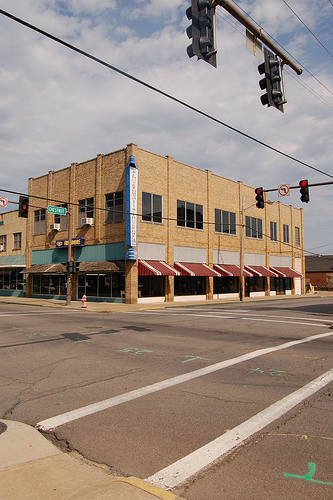
Strong Towns thinks towns like Conway, Arkansas (pictured) aren’t car-dependent by accident – they were designed to be that way. From Jason Schultz.
Towns are largely car-dependent because we design them that way, claims blogger Andrew Price with Smart Towns, a blog devoted to American town growth, in a recent post. Price analyzes the zoning system in Conway, Arkansas, as an example of Euclidean zoning and its role in creating car-dependent towns.
What exactly is Euclidean zoning? Also known as single-use zoning, Euclidean zoning is the most common type of zoning in the U.S., and it segregates land use types into different categories: industrial, commercial, multi-family residential, single-family residential, and others. While it’s familiar and long used, the system is criticized for its inflexibility in allowing organic growth.
“You could argue that we live in a free market country. That all of our decisions are based on what people want – that Conway is sprawled because the people want the city to be sprawled, and that Conway is automobile dependent because people want to drive,” argues Price. “That is a bunch of baloney.” Instead, he writes, the town is sprawling because it was designed that way.
If you look at its zoning map, you’ll see that Conway is neatly blocked off using Euclidean zoning, with every area (except for a few parts of downtown) designated for specific uses. In one specific neighborhood, viewed here, Price argues that the predominance of single-family, detached residential properties, arranged along cul-de-sacs and disconnected streets, is one reason people tend to drive instead of walk; the streets are designed to serve, as the town’s ordinance says, “persons traveling by automobile.”
“A common reason people drive is that distances are too far to walk,” argues Price. “The other is that it is too dangerous.” The town’s design — with designated residential areas and designated retail areas, for example — means that there are few walkable destinations. The areas are so segregated that car travel is necessary. “Only very few people will ever live within walking distance of a destination so rarely would anyone in this neighborhood attempt to walk.”
Compounding the problem for pedestrians, the town’s retail areas are designed for drivers. “If everyone else drives there – why do you want to be the only one that walks?” Price questions. These shopping areas are designated by the town’s ordinance “to encourage the development of recognizable, attractive groupings of facilities to serve persons traveling by automobile.”
Price’s suggested solution to such sprawl is a maximum use-based zoning scheme, addressing the downfalls of Euclidean zoning, as he sees them, which are: 1) prevention of incremental growth; 2) siloed land uses that ignore market forces; and 3) micromanagement of the use of each parcel of land.
An improved system, he argues, “…would be one where uses and zones are sorted by their ‘annoyance level’ – the higher the zone, the higher the ‘annoyance level.’” To use his example, a store might annoy a homeowner next door, but the store owner might not be annoyed by the home. “Businesses have a higher ‘annoyance level’ than houses. By breaking down uses by how ‘annoying’ they are, we can come up with a simple table of zones and uses,” which can be viewed here.
In the residential zone, the town would permit incremental development up to detached homes. Those who want to live in an entirely residential area, free of other development, Price says, would live in this zone. Neighborhood zones would include detached houses, schools, corner stores, and other developments “typically [found] in pre-war neighborhoods.”
Town zones would host medium-rise urban and auto-targeted development, “allowing the market to determine in which direction there is demand for.” Lastly, business zones would function as the “urban core” of medium and large cities, and industrial zones would permit development of all kinds.
While the advantages of this system are clear — its allowance for incremental growth based on town residents’ wishes and market demand, for example — it raises a number of questions. For one, how is the “annoyance” level determined? How are residents’ interests balanced with those of small businesses, big businesses, and other would-be developers? Who determines what qualifies as a neighborhood corner store? Is there a legal way to exclude chain stores deemed “annoying” by residents?
Price’s zoning system is an interesting one, but it may also devolve into segregation of the kind he is trying to prevent. For example, store-free residential zones might prove to be the more desirable living areas, raising prices, creating isolation and further reliance on cars to get to the less desirable areas where big-box stores, and lower-income residences, are located. Concerns about safety in these less desirable areas would likely lead to increased auto use.
While an ideal zoning system clearly does not exist, Price’s maximum use alternative is compelling to consider. Significant questions as to its efficacy and equity for residents, and striking a balance between business and residential interests, however, remain to be addressed.